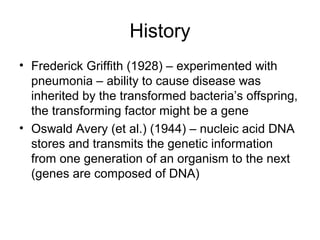
Dna
- 1. History • Frederick Griffith (1928) – experimented with pneumonia – ability to cause disease was inherited by the transformed bacteria’s offspring, the transforming factor might be a gene • Oswald Avery (et al.) (1944) – nucleic acid DNA stores and transmits the genetic information from one generation of an organism to the next (genes are composed of DNA)
- 2. Cont. • Hershey-Chase (1952) – genetic material of the bacteriophage was DNA, not protein • Watson-Crick – develop the double-helix model of the structure of DNA • Gilbert-Maxam-Sanger (1977)-develop methods to read the DNA sequence • Human Genome Project (2000) – sequence all human DNA
- 3. Function of DNA • 1. genes have to carry information from one generation to the next • 2. put information to work by determining the heritable characteristic of organisms • 3. genes have to be easily copied
- 4. Components • DNA – long molecule made up of units celled nucleotides • Nucleotides: – 5-carbon sugar – Phosphate group – Nitrogenous base
- 5. Cont. • Purines: • Adenine and guanine • Pyrimidines: • Cytosine and thymine • Form chains in A=T and G=C (Chargaff’s rules) • Base pairing – hydrogen bonds form between certain bases
- 6. Cont. • Chromatin – DNA and a protein (histones) called nucleosomes • Nucleosomes can fold DNA into tiny space
- 7. Replication • Each strand of DNA in the double helix has the exact information needed to copy itself • Produces two new complementary strands following the rules of base pairing • Each strand of the double helix of DNA serves as a template for the new strand
- 9. Cont. • Replication – duplicates its DNA (replication forks) • Enzymes “unzip” by breaking the hydrogen bond • DNA polymerase is the enzyme used in replication and “proofreads” the DNA to maximize the perfect copy of DNA
- 10. RNA and Protein Synthesis • RNA –long chain of nucleotides of sugar, phosphate and base • Differences: – Ribose (sugar) – Generally single-stranded – Contains uracil in place of thymine
- 11. Cont. • Three main types of RNA: mRNA, rRNA, and tRNA • mRNA: carry copies of instructions for assembling amino acids into proteins; serve as a “messenger” for DNA to rest of the cell • rRNA: proteins are assembled on ribosomes
- 12. Cont. • tRNA: transfers each amino acid to the ribosome as it is specified by coded messages in mRNA • Transcription: RNA polymerase binds to DNA and separates the DNA strand, RNA polymerase then uses one strand of DNA as a template from which nucleotides are assembled into a strand of RNA
- 13. Cont. • RNA polymerase enzyme will only bind to DNA regions where promoters are present, which have specific base sequences • Introns are not involved in coding proteins, exons are the DNA sequences that code for proteins and are “expressed” in the synthesis of proteins
- 14. Cont. • Introns are removed from the final RNA molecule and the exons are spliced together to from the mRNA • Proteins form from long chains of amino acids called polypeptides – containing and or all of the 20 different amino acids • mRNA’s “language” of instructions is called the genetic code
- 15. Cont. • Bases on RNA – A, U, C, G read 3 letters at a time, each coded “word” is called a codon and will represent a specific amino acid or stop codons • Translation - decoding or reading of codons takes place in ribosomes, and uses information from mRNA to produce proteins
- 16. Steps in RNA • 1. mRNA transcribes from DNA in nucleus and released into cytoplasm • 2. mRNA in cytoplasm attaches to ribosome and each codon of mRNA moves through the ribosome and specific amino acid is transferred to polypeptide chain ---tRNA has 3 unpaired bases called anticodon
- 17. Mutations • Mutations – mistakes (harmful/beneficial) • Changes in genetic material • Point mutation happens at a single point in a base and includes: substitution, deletion, and insertion and are called frame shift mutations • Causes can be dramatic as code has “shifted” from that point on
- 18. Cont • Chromosomal mutations • Deletion – loss of all or part of chromosome • Duplication – extra copy is produced • Inversion – reverses the direction of parts of chromosomes • Translocation – chromosome breaks off and attached to another
- 19. Cont. • Harmful – cause many genetic diseases (Down Syndrome, Turner’s syndrome, Fragile X syndrome and cancers) • Beneficial – large crops, allows for variations in species
- 20. Progeria
- 22. 22q11 deletions
- 23. Wolf-Hirschhorn
- 25. Proetus Syndrome
- 26. Regulation • Operon – group of genes that operate together • Eukaryotic genes are controlled individually and have regulatory sequences that are complex • Differentiation – specialized structure and function • Hox genes – control cells and tissues